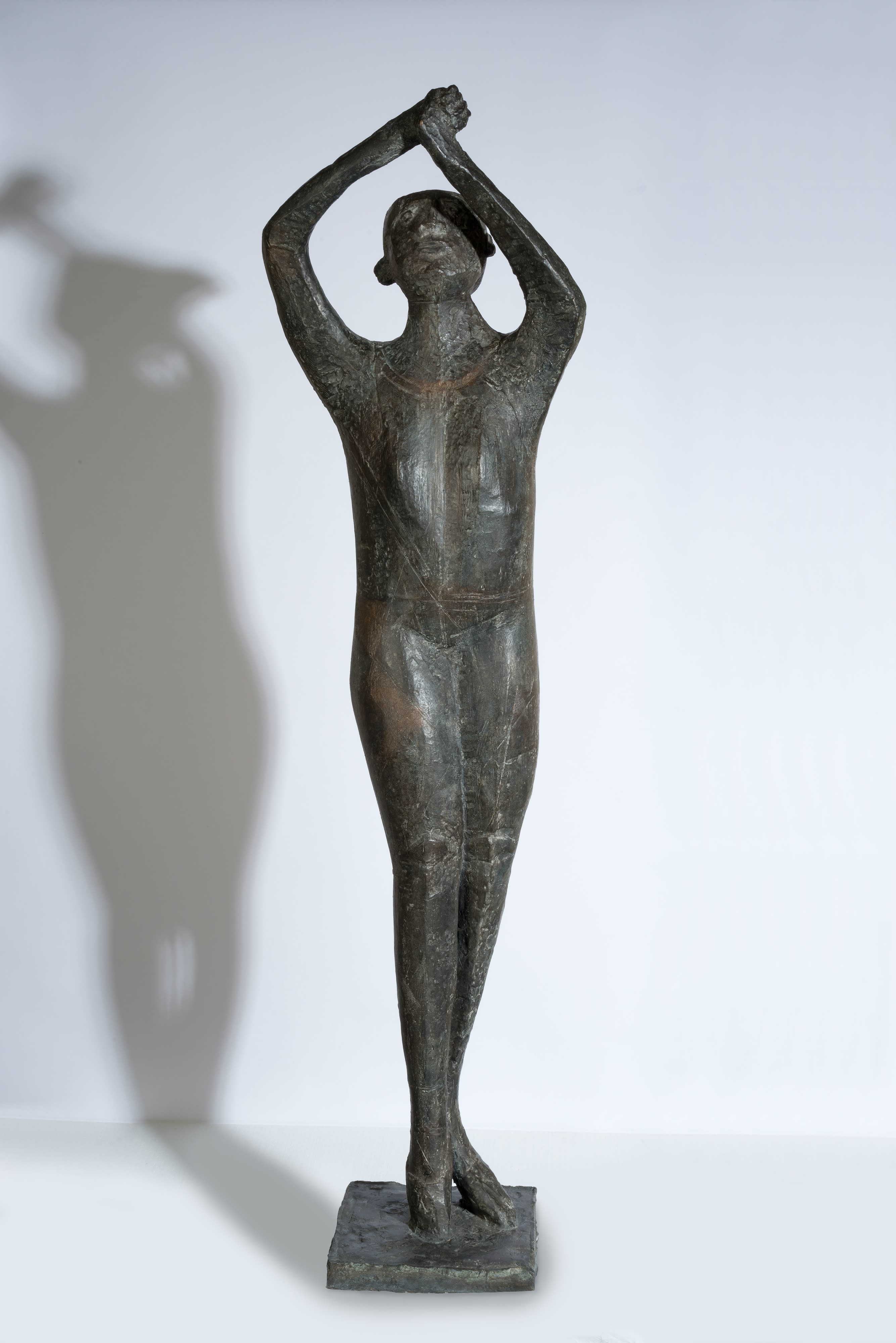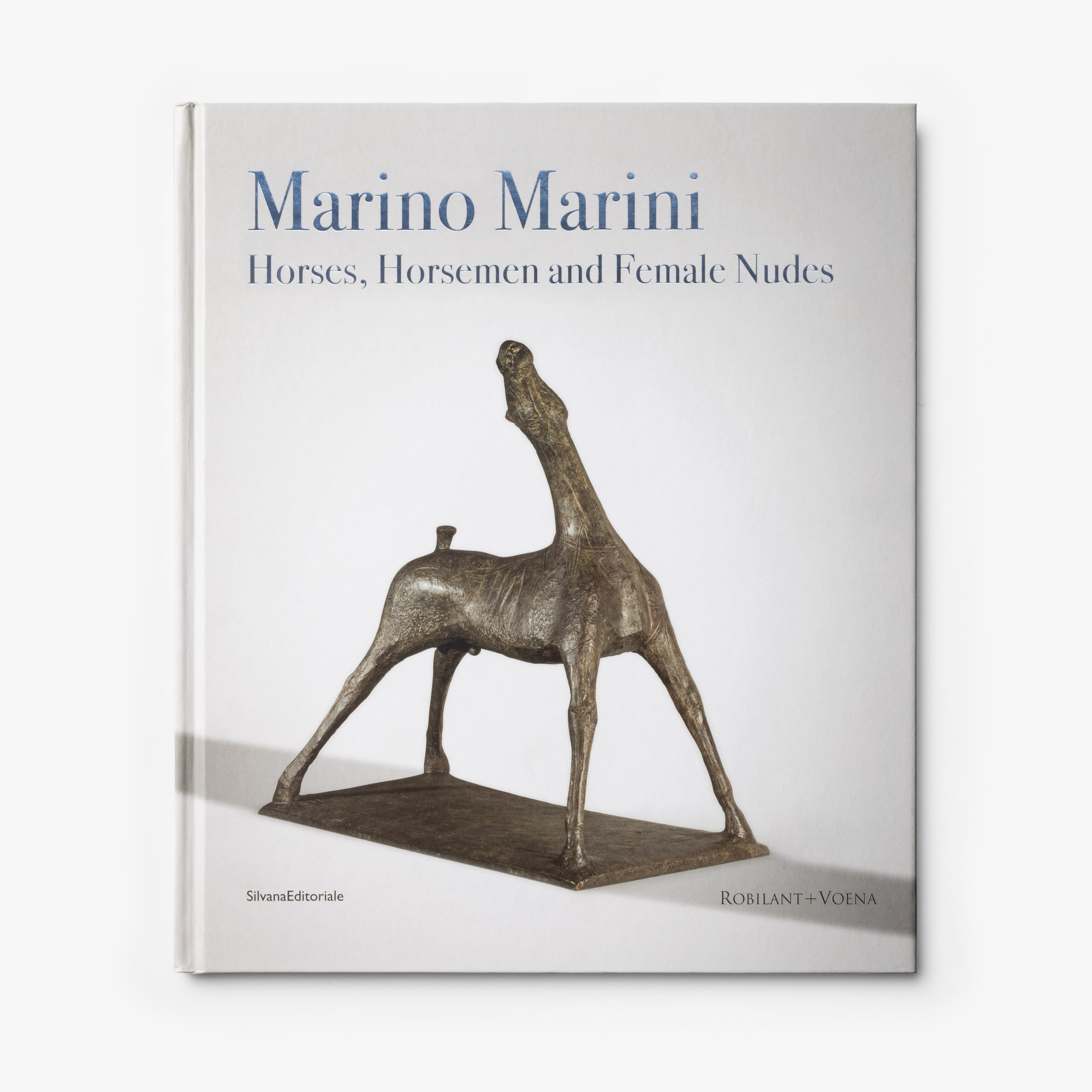Marino Marini
b. 1901, Pistoia, Italy
d. 1980, Viareggio, Italy
Danzatrice (Dancer)
1953
Bronze
162.5 x 45 x 35 cm (64 x 17 3/4 x 13 3/4 in.)
Edition of 4
Provenance
with Blair Laing Gallery, Toronto, 1961,
Walter Carsen, Toronto, before 1970,
with Hanover Gallery, London, 1996,
Christie’s, New York, 1 May 1996, lot 376,
with Galleria dello Scudo, Verona,
Private collection.
Walter Carsen, Toronto, before 1970,
with Hanover Gallery, London, 1996,
Christie’s, New York, 1 May 1996, lot 376,
with Galleria dello Scudo, Verona,
Private collection.
Literature
G. Carandente (ed.), Marino Marini. Catalogo ragionato della scultura, Milan, 1998, p. 86, illustrated 378B.
Related Literature
E. Trier, The Sculpture of Marino Marini, London, 1961, illustration of a polychrome plaster version, pl. 13.
E. Trier, The Sculpture of Marino Marini, London and Stuttgart, 1961, illustration of a polychrome plaster version, cover and pp. 104-7.
G. Carandente, Marino Marini: Lithographs 1942-1965, Milan, 1966, pl. XI.
A. Busignani, Marino Marini, Florence, 1968, illustration of a plaster version without arms, pl. 30.
A.M. Hammacher, Marino Marini Sculptures, Painting, Drawings, New York, 1970, illustration of a polychrome plaster version, pl. 199-200.
H. Read, P. Waldberg, and G. di San Lazzaro, Marini, Complete Works, New York, 1970, pp. 138, 146-47 c.s.n. 307abc.
C. Pirovano, Marino Marini, Scultore, Milan, 1972, fig. 52, 60 c.s.n. 307abc.
A. Merse Szinyei, Marini, Budapest, 1977, fig. 35.
Marino Marini, exh. cat., Tokyo, National Museum of Modern Art, April-June 1978, fig. 89, 131.
C. Pirovano, Marino Marini, Catalogo del Museo di San Pancrazio di Firenze, Milan, 1988, fig. 147-48 pp. 158-59.
G. Iovane, Marino Marini, Milan, 1990, p. 74.
C. Pirovano, Marino Marini, Museo San Pancrazio, Milan, 1990, p. 66.
G. Gentile, Marino Marini, Pomone and Female Nudes, Milan 1991, pl. 40-41-43-44-45.
S. Hunter, Marino Marini Sculptor, New York, 1993, p. 116.
Related Literature
E. Trier, The Sculpture of Marino Marini, London, 1961, illustration of a polychrome plaster version, pl. 13.
E. Trier, The Sculpture of Marino Marini, London and Stuttgart, 1961, illustration of a polychrome plaster version, cover and pp. 104-7.
G. Carandente, Marino Marini: Lithographs 1942-1965, Milan, 1966, pl. XI.
A. Busignani, Marino Marini, Florence, 1968, illustration of a plaster version without arms, pl. 30.
A.M. Hammacher, Marino Marini Sculptures, Painting, Drawings, New York, 1970, illustration of a polychrome plaster version, pl. 199-200.
H. Read, P. Waldberg, and G. di San Lazzaro, Marini, Complete Works, New York, 1970, pp. 138, 146-47 c.s.n. 307abc.
C. Pirovano, Marino Marini, Scultore, Milan, 1972, fig. 52, 60 c.s.n. 307abc.
A. Merse Szinyei, Marini, Budapest, 1977, fig. 35.
Marino Marini, exh. cat., Tokyo, National Museum of Modern Art, April-June 1978, fig. 89, 131.
C. Pirovano, Marino Marini, Catalogo del Museo di San Pancrazio di Firenze, Milan, 1988, fig. 147-48 pp. 158-59.
G. Iovane, Marino Marini, Milan, 1990, p. 74.
C. Pirovano, Marino Marini, Museo San Pancrazio, Milan, 1990, p. 66.
G. Gentile, Marino Marini, Pomone and Female Nudes, Milan 1991, pl. 40-41-43-44-45.
S. Hunter, Marino Marini Sculptor, New York, 1993, p. 116.
Description
Marino Marini is one of the foremost sculptors of twentieth-century Italy. Marini’s practice focused on modernist reinterpretations of classical themes like the equestrian figure, the female nude and the portrait bust. Though toward the end of his career his style became increasingly abstract, Marini often drew inspiration from artistic traditions of the past, from sources as diverse as Etruscan art and the sculpture of medieval northern European craftsmen. Born in Pistoia, Marini commenced his training at the Accademia di Belle Arti in Florence in 1917 and from 1922 turned almost exclusively to sculpture. In 1929, he succeeded his teacher and mentor Arturo Martini as professor at the Scuola d’Arte di Villa Reale di Monza, retaining the position until 1940, when he accepted a professorship at the Accademia di Belle Arti di Brera. Over the course of the next two decades, Marini achieved international recognition. In 1949 his work was included in the seminal exhibition entitled Twentieth-Century Italian Art, held at the Museum of Modern Art in New York, and the following year, the Buchholz Gallery in New York began showing his work. Exhibitions at the Hanover Gallery in London, the Kestner-Gesellschaft in Hannover, the Kunstverein in Hamburg and the Haus der Kunst in Munich followed. He received the Grand Prize for Sculpture at the 1952 Venice Biennale and the Feltrinelli Prize at the Accademia dei Lincei in Rome in 1954.
In the decade following the Second World War, Marini explored new articulations of forms. In series like the Jugglers, made between 1953 and 1956, he experimented with the sense of blocked motion and tension in the figures, focusing on moments of transition. In the present Dancer, Marini achieved great elegance and grace by attentively weighting, interconnecting and closing volumes. Rather than defining the musculature of his figure, Marini employed subtle curves to capture the sense of tension and effort fundamental to the dancer’s movement. “The dance is shown to us, not in repose, for such a thing does not exist in the sphere of dance, but in a state of suspense, that instant of straining stillness where action either emerges or else expires” (H. Read, P. Waldberg and G. Di San Lazzaro, Marini. Complete Works. New York, 1970, p. 134). This version of the Dancer embodies the newfound harmony and stylistic refinement achieved by the artist after the turbulence of the war.
At the same time, the present work perfectly marries a classicising form with a modern sensibility to create a sense of the eternal, a longstanding hallmark of Marini's practice. As Marini once noted, he sought to endow his works with “a classical quality of anonymity. I have tried to express in them no personal sensuality of my own. I wanted to exclude from them the autobiographical element that allows us to recognize, in sculptures of Renoir or even Maillol, the artist’s own mistress or at least a particular contemporary type of feminine beauty that appealed to the sculpture more immediately than an eternal type of classical beauty” (quoted in S. Hunter, Marino Marini, The Sculptor, New York, 1993, p. 171).
The other three bronze versions of Danzatrice are located in the Art Gallery of Ontario; the Pierre Matisse Gallery, New York, before 1979; and in a private collection. Two other casts of the sculpture exist and are made of polychromatic gesso and lead. These can be found in the Museo Marino Marini, Florence, and the collection of Riccardo Jucker in Milan, respectively.
In the decade following the Second World War, Marini explored new articulations of forms. In series like the Jugglers, made between 1953 and 1956, he experimented with the sense of blocked motion and tension in the figures, focusing on moments of transition. In the present Dancer, Marini achieved great elegance and grace by attentively weighting, interconnecting and closing volumes. Rather than defining the musculature of his figure, Marini employed subtle curves to capture the sense of tension and effort fundamental to the dancer’s movement. “The dance is shown to us, not in repose, for such a thing does not exist in the sphere of dance, but in a state of suspense, that instant of straining stillness where action either emerges or else expires” (H. Read, P. Waldberg and G. Di San Lazzaro, Marini. Complete Works. New York, 1970, p. 134). This version of the Dancer embodies the newfound harmony and stylistic refinement achieved by the artist after the turbulence of the war.
At the same time, the present work perfectly marries a classicising form with a modern sensibility to create a sense of the eternal, a longstanding hallmark of Marini's practice. As Marini once noted, he sought to endow his works with “a classical quality of anonymity. I have tried to express in them no personal sensuality of my own. I wanted to exclude from them the autobiographical element that allows us to recognize, in sculptures of Renoir or even Maillol, the artist’s own mistress or at least a particular contemporary type of feminine beauty that appealed to the sculpture more immediately than an eternal type of classical beauty” (quoted in S. Hunter, Marino Marini, The Sculptor, New York, 1993, p. 171).
The other three bronze versions of Danzatrice are located in the Art Gallery of Ontario; the Pierre Matisse Gallery, New York, before 1979; and in a private collection. Two other casts of the sculpture exist and are made of polychromatic gesso and lead. These can be found in the Museo Marino Marini, Florence, and the collection of Riccardo Jucker in Milan, respectively.





